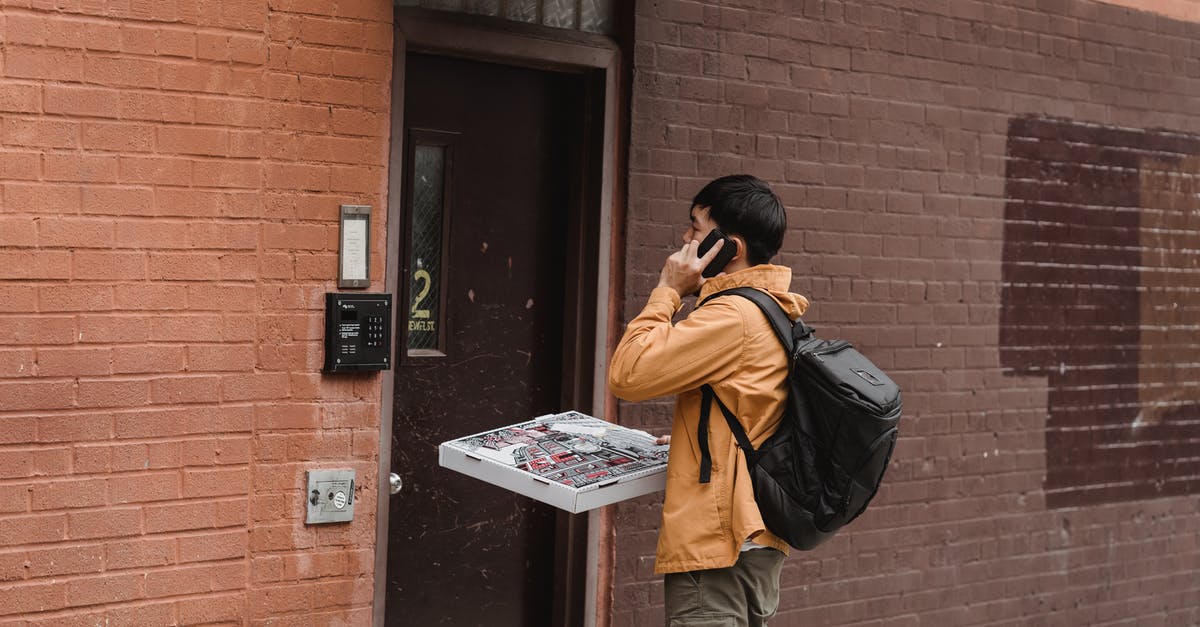Pizza without yeast

I was wondering if it is possible to make a good pizza dough without yeast.
The only other things I can think of for leavening are baking soda, baking powder, and eggs, all of which are in most dough and batters.
My momma has run out of her active dry yeast so unless I can make pizza without yeast, I am stuck with bread or store bought crust if I want to make my own pizza and pizzerias and some grocery stores if I want pizza without all the extra work.
Now don't get me wrong, I love making myself a personal pizza using 4 pieces of bread (multi-grain is usually what I have) but it would be nice if I could make pizza dough without the yeast. Of course I will need multiple rises (I think 2 rises are needed for a good pizza dough and the leavening agents that I listed up top that aren't yeast can only do 1 rise so I will have to add the leavening agent twice.
This is a bit of a problem. Dough that tastes like eggs even after baking is not what you want for a pizza, nor are the tart spots you get with baking soda or baking powder.
So how can I avoid this problem with the taste while adding leavening agents like eggs and baking soda and baking powder when I have no yeast?
Best Answer
It will depend a lot on what you want out of your pizza dough.
Are you looking for pizza dough that's thick, fluffy, rich, floppy, chewy, crisp, dry, flaky, crumbly? You can make good pizzas with any of these characteristics, and you can also prefer (even strongly) some over others. Changing leavening will change taste and texture, but it's up to you to say if the result is acceptable to you or not. I'm usually pretty happy with any of the above, as long as the tomato sauce and cheese and toppings tastes are all there with the crust.
You can make pizza with sourdough, which will take more time, and have a different flavor, but give a nicely risen end result. More investing in the beginning, but once the starter is running it will be very conveniently on hand. You can use bread dough (which I know needs yeast itself, but if you had a ball of the frozen sort hidden away, it can be pressed into service) and the results will be similar to, but not necessarily the same as, a made-for-pizza dough.
You can make baking powder pizza doughs, as Joshua Engles suggested, for a thin crisp crust, or use baking-powder risen biscuit dough or even pancake batter as the base for something thicker and fluffy rather than chewy.
You can use tortillas (either store-bought or handmade) as the basis for some nice, thin, pizzas, either floppy or very crisp - and they store pretty well, so it's usually little trouble to have an unopened pack tucked away in the pantry. You can use pie crust for a flaky, but very flat crust (though I've seen stuffed pocket-pastries more so than open faced pizza this way). Puff paste is also a fine, rich tasting option, as rackandboneman suggested.
Two other points - if you can grab store-bought crust or grocery-store pizza, you can also pick up yeast, yes? I mean, it solves the problem at the source. You can keep yeast in the freezer if you want to buy extra.
Also, this I'm not sure of, but I think pre-made (frozen, say) bread or pizza dough might be usable as a source for yeast, not just as an ingredient - take a bit out, and treat like a preferment or biga or poolish (look it up more specifically if you would like to try it - but generally, it's something like mix with equal parts flour and water till quite loose, give extra time [ie, overnight] for the yeasts to multiply and take over the world, mix back into dough and bake).
Or alternatively and more certainly, keep a bit of the batch of dough from the last of the yeast you had, and use it as a pate fermentee, or old dough, or mother-dough starter, where each batch uses some reserved dough as a starter, and has some reserved after rising for the next batch.
Bonus troubleshooting, after rereading your post - you mentioned wanting two raises, this helps when your yeast gets extra time to work in the dough and change the texture, and develop flavors, and all that. The actual raising doesn't actually do much for the dough once beaten down or spent, so when using other kinds of leavening only one raise is needed, and two may cause problems (off flavors from too much spent agent, etc). Also, you shouldn't get tart spots in your dough with baking soda or powder unless you're using too much (like enough for raising twice?) and/or don't mix enough so the baking powder or soda ends up unevenly mixed in the dough. And finally, the raising you get from eggs is mostly the proteins in whites plus any trapped air that has been whisked into it that survived the mixing, so you might be able to use less yolk to reduce any "eggy" flavor... whites are fairly subtle in flavor to begin with.
Pictures about "Pizza without yeast"



What can I use instead of yeast for pizza?
Here are the 3 best substitutes for yeast.Is yeast necessary for pizza dough?
Yeast is the one ingredient a pizza dough needs the most. Yeast is the primary leavening agent in dough, which means it's what causes the pizza dough to rise. The best pizza dough recipes produce dough that rises quickly, making for an airy and bubbly crust.15-Minute Pizza Recipe | No Yeast Dough! | Bigger Bolder Baking
More answers regarding pizza without yeast
Answer 2
If you have time, you could create your own sourdough starter and use sourdough for pizza baking.
I think.
I'm baking bread without yeast, only with well developed sourdough. Since pizza is just some kind of flat bread garnished with some toppings, this should work.
Recipe: http://www.kingarthurflour.com/recipes/sourdough-pizza-crust-recipe
Forget baking soda and baking powder. No need to buy any artificial agents. Just water and flour!
Edit: just noticed that the recipe calls for an awful industrial ingredient called pizza dough flavour. Just don't do that. We're not cooking our own meals with nice stuff and then put in the crap that is used in factory food, right?
Sources: Stack Exchange - This article follows the attribution requirements of Stack Exchange and is licensed under CC BY-SA 3.0.
Images: Katerina Holmes, SHVETS production, SHVETS production, Mike Jones
